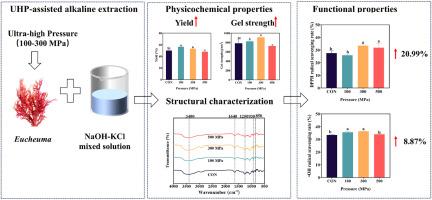Impact of ultra-high pressure assisted alkaline extraction on properties and structural characteristics of carrageenan
IF 11
1区 农林科学
Q1 CHEMISTRY, APPLIED
引用次数: 0
Abstract
This study investigated the effects of ultra-high pressure (UHP)-assisted alkaline extraction on the physicochemical and structural properties of carrageenan. UHP treatment between 100 and 300 MPa significantly enhanced performance, with yield increasing by 12.7 % at 100 MPa and gel strength reaching 911.57 g/cm2 at 300 MPa, accompanied with a 16.15 % improvement when compared with the control. Compositional analysis showed a 13.26 % reduction in sulfate groups and a 19.63 % increase in 3,6-anhydrogalactose at 300 MPa, together with higher uronic acid (increased by 30.11 %) and total sugar (increased by 13.90 %) contents. These changes resulted in functional improvements, e.g., the elevated water-holding capacity. LF-NMR analysis indicated the reduced water mobility and a higher proportion of bound water for carrageenan treated at 300 MPa. Antioxidant assays further confirmed that carrageenan treated at 300 MPa exhibited stronger radical scavenging activity, with DPPH and •OH clearance rates increased by 20.99 % and 8.87 % (p < 0.05), respectively, whereas treatment at 500 MPa attenuated these effects. Overall, the results demonstrated that moderate UHP treatment, particularly at 300 MPa, effectively improved the structural and functional properties of carrageenan, supporting its potential application as a functional hydrocolloid.

超高压辅助碱性萃取对卡拉胶性质及结构特性的影响
研究了超高压(UHP)辅助碱性萃取对卡拉胶理化性质和结构性质的影响。100 ~ 300 MPa的超高压处理显著提高了性能,在100 MPa下产量提高12.7%,在300 MPa下凝胶强度达到911.57 g/cm2,与对照相比提高了16.15%。结果表明,在300 MPa条件下,硫酸盐基含量降低13.26%,3,6-无氢半乳糖含量增加19.63%,脲酸和总糖含量增加30.11%,总糖含量增加13.90%。这些变化导致了功能的改善,例如,提高了持水能力。LF-NMR分析表明,在300 MPa下处理的卡拉胶的水迁移率降低,结合水比例升高。抗氧化实验进一步证实,300 MPa处理的卡拉胶具有更强的自由基清除能力,DPPH和•OH清除率分别提高了20.99%和8.87% (p < 0.05),而500 MPa处理则减弱了这些作用。总的来说,研究结果表明,适度的超高压处理,特别是300 MPa的超高压处理,可以有效地改善卡拉胶的结构和功能特性,支持其作为功能性水胶体的潜在应用。
本文章由计算机程序翻译,如有差异,请以英文原文为准。
求助全文
约1分钟内获得全文
求助全文
来源期刊

Food Hydrocolloids
工程技术-食品科技
CiteScore
19.90
自引率
14.00%
发文量
871
审稿时长
37 days
期刊介绍:
Food Hydrocolloids publishes original and innovative research focused on the characterization, functional properties, and applications of hydrocolloid materials used in food products. These hydrocolloids, defined as polysaccharides and proteins of commercial importance, are added to control aspects such as texture, stability, rheology, and sensory properties. The research's primary emphasis should be on the hydrocolloids themselves, with thorough descriptions of their source, nature, and physicochemical characteristics. Manuscripts are expected to clearly outline specific aims and objectives, include a fundamental discussion of research findings at the molecular level, and address the significance of the results. Studies on hydrocolloids in complex formulations should concentrate on their overall properties and mechanisms of action, while simple formulation development studies may not be considered for publication.
The main areas of interest are:
-Chemical and physicochemical characterisation
Thermal properties including glass transitions and conformational changes-
Rheological properties including viscosity, viscoelastic properties and gelation behaviour-
The influence on organoleptic properties-
Interfacial properties including stabilisation of dispersions, emulsions and foams-
Film forming properties with application to edible films and active packaging-
Encapsulation and controlled release of active compounds-
The influence on health including their role as dietary fibre-
Manipulation of hydrocolloid structure and functionality through chemical, biochemical and physical processes-
New hydrocolloids and hydrocolloid sources of commercial potential.
The Journal also publishes Review articles that provide an overview of the latest developments in topics of specific interest to researchers in this field of activity.
 求助内容:
求助内容: 应助结果提醒方式:
应助结果提醒方式:


